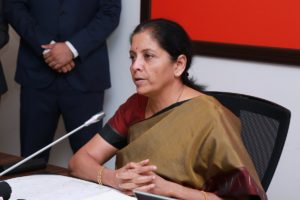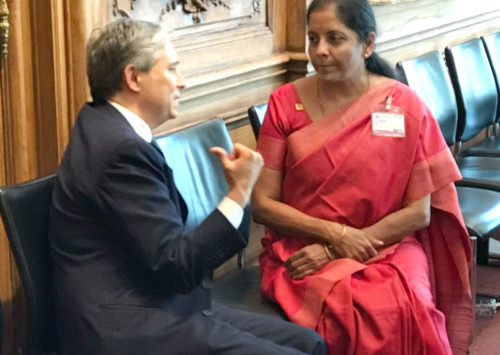Challenges facing new defence minister of India
India’s new defence minister, Nirmala Sitharaman’s 20-month tenure will be fraught with challenges, before the 2019 General Elections.
Nirmala Sitharaman took charge as the 31st defence minister of India on Thursday. She is the second woman to shoulder this responsibility after Indira Gandhi, who held the post twice — first in 1975 and later between 1980 and 82, while she was also prime minister.
Unlike Gandhi, Sitharaman will be a full-time defence minister.
Complexity of issues: Madurai-born Sitharaman, who is an alumnus of the prestigious Jawaharlal Nehru University, has to grapple with complex issues and multiple departments. Each of these departments—defence, defence production, defence finance, research & development, and ex-servicemen, is headed by a secretary. She has to also deal with the problems of three separate wings of the armed forces—army, navy and air force—and address the issue of national security.
National security: The Indo-Pakistan border witnesses frequent ceasefire violations. Containing Pakistan-sponsored terrorism, especially in Kashmir, will be yet another headache. China’s growing military ambitions have been a cause of concern too. The recent standoff at Doklam is a case in point. Experts expect India–China skirmishes to resurface.
Weapon of mass destruction: The defence minister will definitely have to keep in mind the apprehensions regarding weapons of mass destruction. For all practical purposes, she will be the key to India’s national sovereignty and integrity.
Defence preparedness: Shortfall in defence preparedness has been reminded of at regular intervals, due to a shortage of arms and ammunition and obsolete air defence capabilities. In 2015, the Comptroller and Auditor General (CAG) pointed out that 50 pc of tanks and artillery ammunition had stocks for less than 10 days of fighting. Then, the armed forces had to contend with indigenously-manufactured weapons, of inferior quality and quantity. There is a huge demand for fresh ammunitions for infantry, as well as artillery, helicopters, night vision equipment and mine-protected vehicles (MPVs).
Financing: Prime Minister Narendra Modi has broken the glass ceiling by appointing her as the defence minister. But will she get a free hand?
Consider this — The INR 2741.14 billion defence outlay this fiscal works out to just 1.56 pc of the projected GDP, the lowest such figure since the 1962 war with China. Secondly, the Defence Ministry surrenders some of its allocation as the Finance Ministry—which has to approve procurements—deliberately delays until the money lapses. The Parliament Standing Committee on Defence has criticised the inadequate allocation for procurement. The onus is on Sitharaman to rectify the situation.
Make in India: The new defence minister has to drive the modernisation of the Indian armed forces. India is the world’s largest importer of arms. Sitharaman’s stint as commerce and industry minister will be useful, given the Government’s push towards unlocking the potential of defence manufacturing in India, boosting ‘Make in India’, creating jobs and bringing in foreign direct investment.
Global contracts: India is in the midst of a selection process for the biggest project—a contract worth over USD 15 billion to produce new single-engine fighter jets in India. The contest for the contract is between two consortiums: US-based Lockheed Martin and Tata that is offering the American F 16, and the Adani—Saab partnership for the Swedish Gripen.
Similarly, the Indian Navy wants to acquire a new fleet of submarines. Here, global players—Russia, Germany and France are competing for it. Indian firms — Larsen & Toubro as well as Reliance Defence — also hope to be part of the defence deal. The high deal contract calls for a vigilant watch by the new defence minister.
Control on expenses: While driving the modernisation programme of the Indian defence forces, Sitharaman would have to think of ways to keep the expenditure in check. The hike in pay and pension has already badly hit the modernisation drive.
Reforms: The idea of a tri-service chief was first mooted by the Arun Singh Committee in 1990. This again echoed in the suggestions made by the Group of Ministers in 2001 and the Naresh Chandra Committee in 2012. But the IAS-dominated Defence Ministry successfully thwarted all attempts to implement it. Last week, Arun Jaitley who held additional charge of defence announced the 65 of the 95 recommendations made by Lt Gen. Shekatkar Committee. This included closing down departments, such as the Army Postal Service and military farms. This will enable redeployment of 57,000 defence personnel elsewhere, where they are more needed. But he ignored the tri- service reforms. Now it falls on Sitharaman’s shoulders to implement. The Committee claims that it would save INR 250 billion annually.
She must also get professionals on board for policy-making.
Disinvest ordnance factories: India’s state-run defence public-sector undertakings struggle to meet the shortfall in ammunition. As a result, they churn out poor-quality products, which, in turn, impacts operational preparedness. Sitharaman will have to take a call on disinvesting in PSUs, such as HAL, BEL, BEML as well as naval shipyards.
Pay parity: The status of Indian soldiers compared to civilians working for the Government, especially after the 7th Pay Commission has been a cause for concern. Also, it is being pointed out that withdrawal of free rations at peace stations indicates that the contributions made by the armed forces, whether in conflict or peace, are not appreciated.
Gender parity: Indian army began recruiting women to non-medical positions in the military in 1992. Since then, the debate continues for a larger role for women in the Indian army. It is to be seen whether Sitharaman will push for a greater part for women in the military, including opening new combat avenues in the army and navy.
To conclude, unlike Gandhi, Sitharaman lacks the political clout. If you see the list of Modi’s cabinet she is second from the bottom among 27 cabinet ministers, unlike her predecessors — AK Antony, George Fernandes, Sharad Pawar and Jagjivan Ram. So the question is—will her voice prevail?











